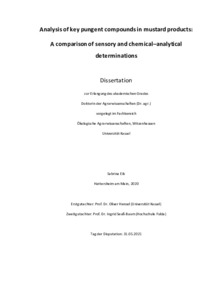| dc.date.accessioned | 2021-08-12T14:30:02Z | |
| dc.date.available | 2021-08-12T14:30:02Z | |
| dc.date.issued | 2020 | |
| dc.identifier | doi:10.17170/kobra-202107254403 | |
| dc.identifier.uri | http://hdl.handle.net/123456789/13097 | |
| dc.language.iso | eng | eng |
| dc.rights | Urheberrechtlich geschützt | |
| dc.rights.uri | https://rightsstatements.org/page/InC/1.0/ | |
| dc.subject | mustard | eng |
| dc.subject | pungency | eng |
| dc.subject | isothiocyanate | eng |
| dc.subject | time-intensity | eng |
| dc.subject | sensory studies | eng |
| dc.subject.ddc | 500 | |
| dc.title | Analysis of key pungent compounds in mustard products: A comparison of sensory and chemical–analytical determinations | ger |
| dc.type | Dissertation | |
| dcterms.abstract | The consumption of mustard, horseradish and wasabi is characterized by a pungent sensation and lachrymatory effect primarily induced by allyl isothiocyanate (AITC). This study aimed to check the possible correlation between sensory-perceived pungency and the quality-determining pungency-inducing ingredients of mustard.
Primarily, the detection thresholds of sinigrin in a water-based matrix and AITC in water- and oil-based matrices were determined in a prestudy and a main study. In the prestudy, the resulting value of the group best-estimate detection threshold (BET) for sinigrin in a water-based matrix was 10.9 mg/100 mL. The BET value for AITC in a water-based matrix was 0.1 mg/100 mL both in the pre and main studies, which differed significantly from that in oil-based matrices with 0.5 and 0.6 mg/100 mL in the pre and main studies, respectively.
Further, a time-intensity (TI) study identified the AITC concentration and carrier matrix composition as significant influencing factors for the intensity and time course of pungency perception. An increase in the AITC concentration increased the maximum perceived pungency intensity (Imax) and extended the duration of pungency sensation (end time of pungency perception TEnd; duration of decreasing phase DURDec).
Additionally, an adapted HPLC method for the quantification of AITC in commercial mustard products was applied. Regression analysis revealed positive correlations between the AITC content and sensory-determined TI parameters Imax, DURDec and AUC (area under the curve) of commercial mustard products. With an increasing AITC content, an increase in the values was observed. Nevertheless, correlation coefficients of 0.944 (Imax), 0.954 (DURDec), and 0.960 (AUC) indicated a very strong correlation between the sensory pungency perception, the AITC concentration and the moisture content of the mustard products.
Moreover, an increasing AITC content provoked a shift from a pungency sensation only on the tongue (at low AITC concentrations to an additional and a more intense pungency sensation in the throat and nose region.
In summary, the established regression model highlights the relationship between predominantly AITC induced pungency perception and the AITC content of mustard products and may facilitate the reduction of necessary sensory evaluations in quality assurance and product development of pungent products. | eng |
| dcterms.accessRights | open access | |
| dcterms.creator | Eib, Sabrina | |
| dcterms.dateAccepted | 2021-05-31 | |
| dcterms.extent | VI, 132 Seiten | |
| dc.contributor.corporatename | Kassel, Universität Kassel, Fachbereich Ökologische Agrarwissenschaften | ger |
| dc.contributor.referee | Hensel, Oliver (Prof. Dr.) | |
| dc.contributor.referee | Seuß-Baum, Ingrid (Prof. Dr.) | |
| dc.subject.swd | Senf <Lebensmittel> | ger |
| dc.subject.swd | Schärfe | ger |
| dc.subject.swd | Isothiocyanate | ger |
| dc.subject.swd | Acylisothiocyanate | ger |
| dc.subject.swd | Wahrnehmung | ger |
| dc.subject.swd | Lebensmittelqualität | ger |
| dc.subject.swd | Produktentwicklung | ger |
| dc.type.version | publishedVersion | |
| kup.iskup | false | |
| ubks.epflicht | true | |

